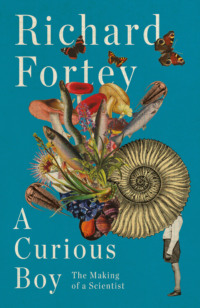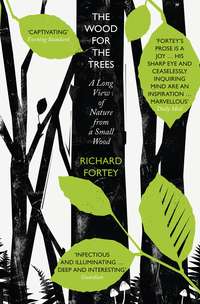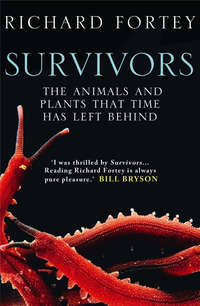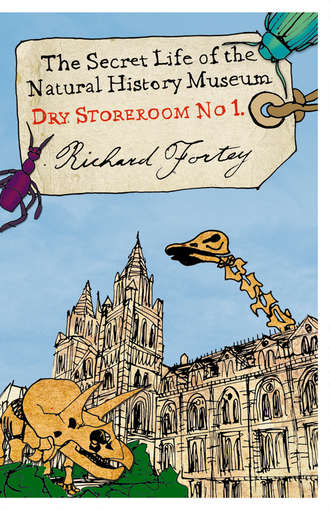
Полная версия
Dry Store Room No. 1: The Secret Life of the Natural History Museum
Now that it is clear that natural history museums have an increasingly important role in a world whose biodiversity is threatened, I should perhaps explain the nuts and bolts of naming animals and plants. Readers who are gardeners or ornithologists will be accustomed to calling their plants or birds by scientific names. These names provide a common language for all biologists around the world, because they are the official name, the agreed nomenclature. If the name Larus ridibundus is used by a Japanese, an American or even an inhabitant of the Philippines, it is the same bird species that is being identified, regardless of the local name; ‘black-headed gull’ just happens to be our British local name for this particular bird, but few Englishmen would know what the Japanese might call it. Different gull species would be just as precisely specified by their scientific names: Larus argentatus (our herring gull), Larus atricilla (laughing gull to an Australian) and so on. Plants can have many different vernacular names for the same species, even within the same country. In his magisterial Flora Britannica Richard Mabey tells us that Cow Parsley is known as Queen Anne’s lace, kex, kecksie, mummy die, grandpa’s pepper, badman’s oatmeal, blackman’s tobacco and rabbit meat. Anthriscus sylvestris may lack the charm of these local names, but it means the same to all interlocutors, regardless of their origin. The scientific name for a species has to be a unique two words, or binomial, so it differs from human names in this respect, where there is no limit to the number of John Smiths. The name has two parts: first, the genus (or generic) name which is invariably capitalized; the second, the species (or specific) name, which is never capitalized even if it obviously named after a person – as in johnsmithi. The latter is a convention, as is the italicization of the scientific name, which readily allows recognition of a scientific appellation in a sheet of printed text. When the same generic name appears in a list, it is customary to abbreviate it to the initial letter, as, for example, in remarking that a collection of birds’ eggs included examples of those of Larus ridibundus, L. atricilla and L. argentatus.
If no two animals may have the same scientific name, neither may any two plants. I do not believe it is against the rules to use the same name for a plant and an animal since there is little chance of confusing an ant with a liana. I have toyed with the idea of naming a trilobite Chrysanthemum just to be mischievous. A unit of classification is a taxon (the plural is taxa), and that is why the business of naming them is taxonomy. Scientific names have a long tradition of taking Latin or Greek form. This goes back to the days when scientific communication was in Latin, as the language understood by the intellectual classes across Europe. In the early eighteenth century descriptions and names of plants and animals were often rather unwieldy slabs of Latin. The present simple system of naming and classifying animals and plants was developed in the eighteenth century by the Swede, Carl von Linné, who is himself nearly always latinized to Linnaeus: he it was who showed the utility of the binomial to characterize the species of the living world.
Linnaeus’ tercentenary was in 2007. As part of the celebrations I was asked to reply to a speech given at the Linnean Society of London by His Imperial Majesty Emperor Akihito of Japan. Thanks to Linnaeus, His Majesty was able to talk to his fellow ichthyologists about his favorite organisms, small fishes called gobies. I was told that the trees in the Imperial Garden are labelled with their scientific names. We all understood one another, and everyone smiled. Linnaeus worked in his maturity in the charming and ancient city of Uppsala; his system triumphed because of its utility and comprehensiveness. He developed his ideas in plant classification as a young man during travels to Lappland – then a daring undertaking. A quirky portrait of him dressed in Lappish robes was actually painted in Amsterdam a few years later, but it does seem that, like Darwin on The Beagle, a youthful adventure set him on the course to greatness. His classification of plants was based on such features as counting the number of stamens – it was a sexual system. Some young ladies were forbidden to study it because it might bring a blush to their delicate cheeks. Linnaeus’ mission to classify knew no bounds: he moved from plants to animals. Deus crevait, Linnaeus disposuit (God created, Linnaeus organized) served as his motto. He distributed his binomials far and wide. The Botanical Garden he laid out in Uppsala, with neat beds arranged according to his system, is still in good order. It ought to be one of the holy places for scientists to visit. Even if the simple sexual system has now been superseded the legacy of the names lives on. Linnaeus’ higher and more inclusive levels of organizing organisms into Order and Class and Kingdom are also still used as part of the hierarchy of the system. The labels on the cupboards that I passed in my peripatetic passage around the Natural History Museum were mostly family names, and the family originated as a unit of classification slightly later.* Inside a given cupboard the curator might have placed a number of species belonging to several genera, all embraced by the family whose name is on the door. It is, if you like, a sophisticated filing system, and if you have millions of specimens the necessity of a filing system that works is patently obvious. I will leave until later in this chapter the question of what the filing system actually means in terms of evolution and ancestry, since Linnaeus lived and worked in a pre-Darwinian world, although I should say that like all taxonomists he used the features of the plant or animal concerned as the basis for his classification. The convention of using Latin and Greek for names was easy work for the early taxonomists. Most of them had been educated in the classics, and they knew their way around mythology and literature. Quite soon a whole dictionary of gods, goddesses, nymphs and satyrs had been recruited to label the natural world, mostly as generic names. Daphne is a flowering shrub, Daphnia is a water flea; Daphne herself was a nymph pursued by Apollo, and changed into a bay tree, as always seemed to be happening in those days. The bay tree itself is Laurus nobilis, ‘noble’ because the aromatic leaves were used to crown the brows of heroes.
Like nobilis, species names often were, and still are, epithets describing some salient feature of the animal or plant in question. A very beautiful plant might be the species magnifica, a very ugly one the species horrida. The specific names can be much more complicated, produced by splicing several Latin words together, so that a species with bright green leaves might be viridifolia, or one with leaves resembling the skin of a crocodile crocodilifolia; this complexity is fortunate, since a very large number of names are needed to accommodate all the beetles. It is necessary for the describer to have at least some knowledge of the classical languages because of the rule that genera have gender – masculine, feminine or neuter – and the species name should therefore agree in gender with that of its genus. The suffix on a genus -us is masculine and requires a matching -us on the species. The suffix -a is feminine, so that a commonly cultivated shrub originating from South America is Fuchsia magellanica and not Fuchsia magellanicus; -um is a neutral ending. Incidentally, Fuchsia is named after a famous herbalist, Leonhard Fuchs, who illustrated plants most decoratively two centuries before Linnaeus, and although Fuchs was evidently male, the genus named for him is female. This paradoxical practice is very common in botany: the well-known names Forsythia, Buddleia and Sequoia are comparable cases. To add a little Gormenghast to the nomenclatural mixture, Fuchsia (not italicized) was a decidedly female character in Mervyn Peake’s Gothic extravaganza, thus completing Fuchs’ sexual transmutation on the human scale. The epithet magellanica is a reference to the occurrence of the shrub as far south as the Straits of Magellan rather than a direct reference to the great explorer. However, as with Fuchs, it is quite common to name a plant or animal genus or species after somebody, often to honour his or her contribution to the field of study. I have done it myself for people who have collected specimens and then presented them to the Museum collections, or for professors who deserve recognition for all their hard work. It confers a modest piece of immortality. In the case of a species one needs to add a genitive suffix – as in Fuchsia johnsmithi – to show that this is John Smith’s species of Fuchsia. There are a few named forteyi species of fossil, all of them remarkably handsome examples of their kind. I should add that it is not regarded as good form to name a species after oneself; somebody else has to do it; modesty forbids after all. Nor is it permitted to cause offence by naming a creature johnsmithi after John Smith while stating that it is the most unattractive member of the genus. I have to say that Linnaeus himself did not follow this prescription, and named a useless weed Siegesbeckia after one of his enemies.
Humour is a delicate matter in nomenclature. The clam genus Abra is crying out to be married with the species name cadabra; and so it was in a species named by Eames and Wilkins in 1957: Abra cadabra, a very satisfactory touch of humour. However, a subsequent authority decided that the species cadabra did not, after all, belong in Abra – so it was moved to another genus, Theora, and there is nothing very entertaining about Theora cadabra. This kind of decision happens all the time in systematic work, as a subsequent author concludes from careful study that a given species is better included in a genus different from the one to which it was originally assigned. Effectively, this moves the species from one drawer in the collections to another. Old views are dropped and new combinations of names have to be learned; this process is known as revision.
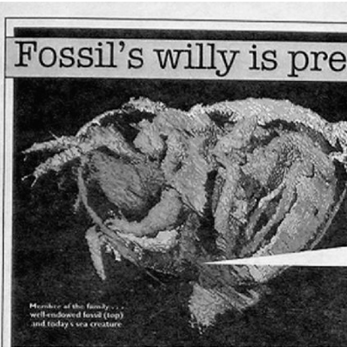
The generously endowed fossil ostracode Colymbosathon ecplecticos causes a sensation in the Sun.
Fossil ostracode Colymbosathon ecplecticos. Photo © David Siveter. Article © The Sun.
Almost as good a pun as the Abra example is one of the numerous carabid beetles I mentioned above – Agra phobia. But my favourite remains the plant bugs described by one G. W. Kirkaldy in 1904. These genera all had the Greek suffix -chisme, pronounced ‘kiss me’. Kirkaldy managed to celebrate all the female objects of his affection by adding the appropriate prefix: Polychisme, Marichisme, Dollichisme and so on (there were rather a lot of them, apparently). Sexual innuendo is evidently irresistible to some taxonomists. It can be more blatant. Professor David Siveter of Leicester University is an expert on small crustaceans called ostracodes. In 2003 he and his colleagues published a paper on a magnificently preserved new fossil genus and species from the Silurian of England, which were some 425 million years old, under the resounding name Colymbosathon ecplecticos. If I might be forgiven for returning to the territory of ‘Biggus Dickus’, the remarkable fact about this ostracode was the size of its fossilized penis: if we translate the Greek, this Silurian species is ‘swimmer with astoundingly large penis’. Oddly enough, this attracted the attention of the press in a way that few new species have ever done. The Sun, always the leader in tastefulness, featured the story under the banner headline ‘OLD TODGER’; the Guardian was hardly less brazen with ‘Well hung geologist’. I doubt whether Science, the distinguished magazine that published the original article, has previously been featured in the pages of the Sun.

To the scientific name is added the namer: Abra cadabra Eames and Wilkins, 1957, or Colymbosathon ecplecticos Siveter et al. 2003. This is so that readers will know who first described the organism concerned, and when. It is remarkable how many plants familiar to Europeans were named first by Linnaeus – certainly almost all the common flowering plants. Botanists like their authors to be abbreviated, and Linnaeus is abbreviated to a bald ‘L.’ – hence, bloody cranesbill is Geranium sanguineum L. The works of Linnaeus are taken as the starting point for all modern scientific names, and everything published earlier is arbitrarily neglected. The beginning of modern nomenclature for plants is his Species Plantarum of 1753, and for animals the tenth edition of Systema Naturae, 1758. Fungi are different, since Linnaeus did not have much to say about them. The greatest early mycological figure, the ‘Linnaeus of mushrooms’, was another Swede called Elias Fries, who seemed to have an almost uncanny memory for these most fleeting ‘vegetable productions of nature’; in fact, modern molecular studies have shown that fungi are not really vegetables at all. His great work published between 1821 and 1832 is a conscious homage to Linnaeus, the Systema Mycologicum, and hence mushroom names go back to 1821, although Fries is said to ‘validate’ certain still earlier names, such as that for the familiar fly agaric, Amanita muscaria, the archetypal red mushroom with white ‘spots’, which Linnaeus had already included in his remit. Quite why Sweden, and in particular the University of Uppsala, should have had such a grip of the system of nature is an interesting question. I went to see Linnaeus’ farmhouse outside Uppsala at Hammarby to find out if it offered any clues. It is a simple wooden building, now painted maroon, with neat white square windows, no different from a hundred others in the more agricultural part of Sweden – sensible, four square and with a proper feeling for place. Maybe the clue was in the very modesty of the structure; nothing showy, just a monument to hard and consistent work – farmers’ virtues, Swedish virtues, Lutheran seriousness.
So far I have said rather a lot about names, but not much about science. The real business of taxonomy is to look closely at the animal or plant in question to assess its features, the business of identification. Only then can you identify a new and unnamed species, or establish whether a previous observer was mistaken about its systematic position. There is no way of generalizing this process, since every different kind of animal or plant is a distinct proposition. If you are ‘spider man’ you don’t climb up walls to save the world as we know it, but you do know a tremendous amount about spider genitalia, because that is the best feature by which to recognize a species. The fern woman will look at the spore capsules on the back of the fronds, and appreciate subtle difference in the way the fronds are subdivided. Flowers and leaves will be the traditional bailiwick of the botanist; spores and microscopic cellular structures on the gill edge will be the province of the fungus man. A crustacean expert will peruse the finest details of the legs and the antennae of his object of study. A mollusc specialist might appraise the colour and ornament of a marine snail, while a lepidopterist will be as familiar with the speckles and dappling of a butterfly wing as he would be with the faces of his own family. One lepidopterist I knew was actually rather more aware of the former than he was of the latter. An ornithologist might listen to songs, spotting their individuality at species or racial level, but then so will an expert on cicadas or bats. Many specialists will take themselves off to the electron microscope, which will afford crisp photographs of the tiniest of organs or ornament on the smallest of animals: bryozoans (‘sea mats’) stand revealed as decorators as virtuosic as Islamic ceramicists; a tiny mite encrusted with horns and growths as Gothic as an extra in a Dracula movie; the cells of a parasite beautifully embroidered with the equipment they need to carry out their depredations; the teeth – radula – of a mollusc as distinctive as a rack of stalagmites. The palaeontologist will have fewer details at his disposal, and so will be obliged to read as much as he can from the testimony of bones or shells – the wonderfully symmetric test of a sea urchin, the calcite exoskeleton of a trilobite, the tiny pollen grains of a plant that has long vanished from the earth.
The next stage is the library. Although memory is important in identifying specimens, sooner or later it must be checked against the printed record. This is the point where the scientist takes himself or herself off to the journals and monographs, wherein will be found descriptions and synopses of species related to the one under the microscope. The appropriate number of the journal will be found in a catalogue, nowadays on a computer, and then the hunt around the miles of shelves will begin. If a new species is to be named it is important to check that it has not been described before, no matter how obscure the book or paper in which it might have first appeared. If an author is unlucky enough to miss an earlier name for an organism then his own will be doomed, for there is an internationally accepted rule that says that the first published name has priority. An unnecessary younger name then disappears into what is termed synonymy. We have already seen that the valid literature goes back into the eighteenth and early nineteenth centuries, so it is not uncommon to find that a species has already been described somewhere else. A great library like that of the Natural History Museum is an enormous asset, because it holds all the old literature. Most university libraries do not. In this regard, systematic science is quite different from physics or chemistry or physiology, subjects in which old literature rapidly becomes obsolete. Most scientists will not cite references dating back more than a decade, and so they will be unfamiliar with the scholarly pleasures of browsing through old, leather-bound tomes. It is also a fact that old literature in taxonomy is often as beautifully illustrated as any modern production, particularly the plants, for the drawings of many of the botanical artists of the eighteenth and nineteenth centuries have never been surpassed. Old is not necessarily out of date. Some of my white-coated scientific friends find something amusingly antiquarian about this emphasis on the past, perhaps an image of pince-nez perched on aquiline noses snuffling around in ancient Serbian publications. It is only a little bit true. Most specialists build up personal libraries, and therefore save their legs, and time, in pounding the library floor. The internet has become a wonderful resource for accessing literature, which can now be posted well beyond the confines of the national libraries. There might come a time when all those miles of shelves will be available online from the comfort of home, although I somewhat sentimentally believe that there is an added value in the physical contact with old books. Whatever circumstances arise in future, the paper originals must be preserved and conserved, even though librarians roll their eyes at the sheer quantity of book storage, because cyberspace is not necessarily truthful, and the web can easily become a web of deceit.
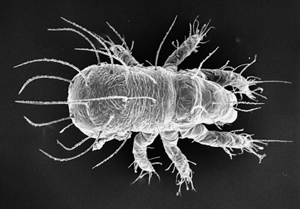
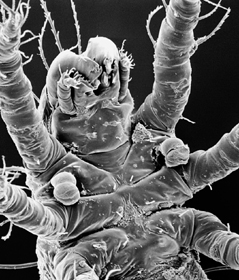
The scanning electron microscope reveals countless unexpected details of taxonomic use. Two views of an orobatid mite larva Archegozetes that would fit onto a pinhead: a dorsal view of whole animal and a detail of the head region from below.
Orobatid mite larva Archegozetes. Photo © Richard Thomas.
It will be problematic indeed to dispense with libraries. At the moment there is a requirement that publications proposing new species should be deposited in one of the copyright libraries – which include our library in London, and the Library of Congress in Washington, and their French, German and Russian equivalents. This is some safeguard against rogue publications and authors setting up new species of animals or plants on spurious grounds. The other safeguard is the system of scientific peer refereeing through which papers submitted to most journals are supposed to pass. An independent reader anonymously says whether the potential publication will pass scientific muster. Neither is foolproof: self-published books can be sent to the libraries and refereeing can be bypassed or inefficient. The eccentric Scottish geologist Archie Lamont set up his own journal, the Scottish Journal of Science, which he published from his private cottage in the small village of Carlops. He could just about fulfil the conditions for valid publication, and he set up all kinds of odd-sounding genera of Cambrian trilobites with Scottish names, like Robroyia and Cealgach on the basis of miserable scraps. Tails might as well be figured as heads in these works. It has taken years to sort out the taxonomic mess. Almost any other group of organisms will potentially tell a similar tale. Mollusc shells are particularly popular, and the most beautiful of molluscs are unusual snails known as cowries. They show a wonderful and seemingly endless variety of colour patterns, speckled and painted in myriad ways. It is perhaps not surprising that amateur conchologists think they have discovered a new species, and seek the immortality acquired through naming one in publications for their fellow enthusiasts. Many of these claims do not bear close scrutiny, for pigment speckling varies naturally within populations, and not every pattern has a biological reality as a species characteristic. But to sort out the true situation requires all the facilities that a reference library has to offer, ungrateful work much of it, pernickety and irritating. All this labour may eventually be reflected in the small print of a list of synonyms; work at the coalface of taxonomy often lacks glamour.
So now our specialist has carefully looked through the pages of a couple of dozen monographs and papers, comparing illustrations of many species with the specimen in front of him. Piles of old books and reprints of papers litter the office floor. He is convinced that the species he is looking at has never been seen before, based on his wide experience of ‘his’ organisms. It is a new species. He now needs to give it a technical description, illustrate it accurately, give it a new name and then get it published. He thinks that it is an exceptionally wonderful example of its genus, so he decides on the specific name mirabilis (Latin, ‘wonderful’, ‘marvellous’). He checks through all the publications before him; sadly, he finds that a Lithuanian Jesuit had already used the epithet mirabilis for a species of the same genus in 1896 in an obscure journal published in Vilnius; this species name is therefore unavailable, and he must find another one. Cursing slightly, he reaches for the Latin dictionary and finds repanda, ‘sought after’, instead; good – this one has never been used before, and it will suffice. The next few days are spent in writing an accurate description of the new species, in language as dry as a James Bond martini, with a differential diagnosis saying how it differs from all species known previously. The language is a disguise for the excitement of finding a species new to science, a formal cover-up, or an epistemological stiff upper lip. He might prepare careful drawings under the camera lucida, or supplement his accurate but slightly soulless drawings with photographs prepared by the Museum’s skilful studio photographers.


